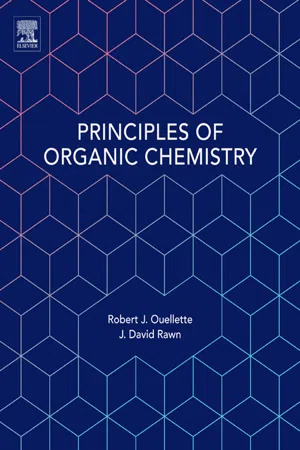
Principles of Organic Chemistry
Robert J. Ouellette,J. David Rawn
- 496 pages
- English
- ePUB (mobile friendly)
- Available on iOS & Android
Principles of Organic Chemistry
Robert J. Ouellette,J. David Rawn
About This Book
Class-tested and thoughtfully designed for student engagement, Principles of Organic Chemistry provides the tools and foundations needed by students in a short course or one-semester class on the subject. This book does not dilute the material or rely on rote memorization. Rather, it focuses on the underlying principles in order to make accessible the science that underpins so much of our day-to-day lives, as well as present further study and practice in medical and scientific fields. This book provides context and structure for learning the fundamental principles of organic chemistry, enabling the reader to proceed from simple to complex examples in a systematic and logical way.
Utilizing clear and consistently colored figures, Principles of Organic Chemistry begins by exploring the step-by-step processes (or mechanisms) by which reactions occur to create molecular structures. It then describes some of the many ways these reactions make new compounds, examined by functional groups and corresponding common reaction mechanisms. Throughout, this book includes biochemical and pharmaceutical examples with varying degrees of difficulty, with worked answers and without, as well as advanced topics in later chapters for optional coverage.
- Incorporates valuable and engaging applications of the content to biological and industrial uses
- Includes a wealth of useful figures and problems to support reader comprehension and study
- Provides a high quality chapter on stereochemistry as well as advanced topics such as synthetic polymers and spectroscopy for class customization
Frequently asked questions
Information
Structure of Organic Compounds

1.1 Organic and Inorganic Compounds
1.2 Atomic Structure
Atomic Orbitals
Table of contents
- Cover image
- Title page
- Table of Contents
- Copyright
- 1: Structure of Organic Compounds
- 2: Properties of Organic Compounds
- 3: Alkanes and Cycloalkanes
- 4: Alkenes and Alkynes
- 5: Aromatic Compounds
- 6: Stereochemistry
- 7: Nucleophilic Substitution and Elimination Reactions
- 8: Alcohols and Phenols
- 9: Ethers and Epoxides
- 10: Aldehydes and Ketones
- 11: Carboxylic Acids and Esters
- 12: Amines and Amides
- 13: Carbohydrates
- 14: Amino Acids, Peptides, and Proteins
- 15: Synthetic Polymers
- 16: Spectroscopy
- Solutions to In-Chapter Problems
- Index